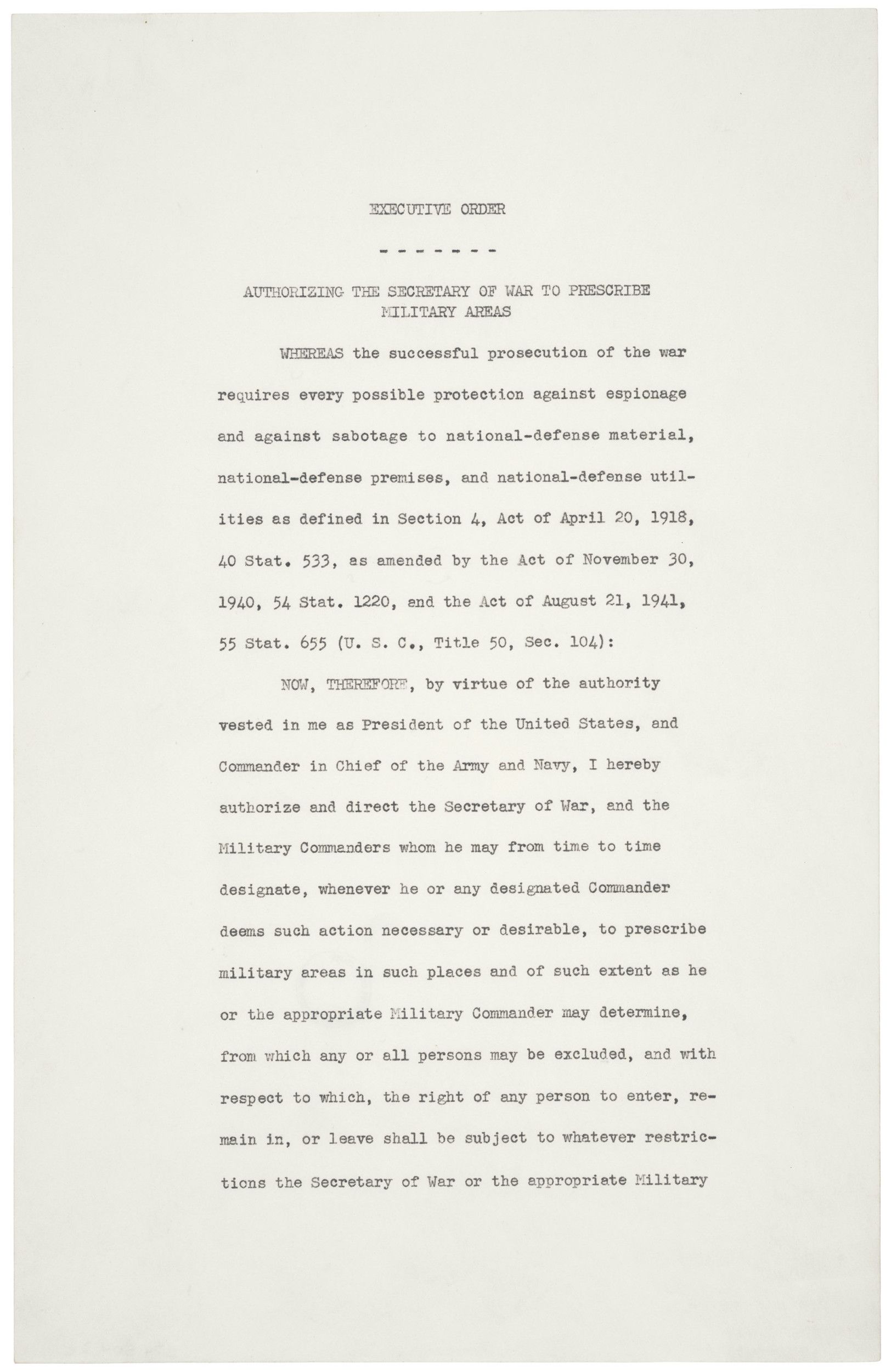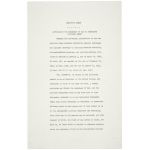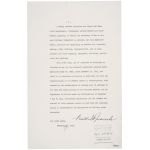Executive Order 9066
2/19/1942
Add to Favorites:
Add all page(s) of this document to activity:

Add only page 1 to activity:
Add only page 2 to activity:
Add only page 3 to activity:
Issued by President Franklin Roosevelt on February 19, 1942, Executive Order 9066 authorized the Secretary of War to evacuate all persons deemed a threat to national security from the West Coast to "relocation centers" further inland.
Prior to the outbreak of World War II, the Federal Bureau of Investigation (FBI) had identified German, Italian, and Japanese aliens who were suspected of being potential enemy agents. Following the attack at Pearl Harbor, the West Coast was divided into military zones and suspect enemy aliens were kept under surveillance. By mid-January 1942, demands arose to exclude not only suspicious aliens whose origins were in belligerent nations, but all persons of Japanese descent, whether foreign born (issei) or American citizens (nisei). During congressional committee hearings, Department of Justice representatives raised constitutional and ethical objections to the proposal, so the U.S. Army carried out the task instead.
The West Coast was divided into military zones, and on February 19, 1942, President Franklin D. Roosevelt issued Executive Order 9066 that authorized military commanders to exclude civilians from military areas. Although the language of the order did not specify any ethnic group, Lieutenant General John L. DeWitt of the Western Defense Command proceeded to announce curfews that included only Japanese Americans. Next, he encouraged voluntary evacuation by Japanese Americans from a limited number of areas; about 7 percent of the total Japanese American population in these areas complied.
On March 29, 1942, under the authority of the President's executive order, DeWitt issued Public Proclamation No. 4, which began the forced evacuation and detention of Japanese-American West Coast residents on a 48-hour notice. Only a few days prior to the proclamation, on March 21, Congress had passed Public Law 503, which made violation of Executive Order 9066 a misdemeanor punishable by up to one year in prison and a $5,000 fine.
From the end of March to August, approximately 122,000 men, women, and children were forcibly moved to "assembly centers." They were then evacuated to and confined in isolated, fenced, and guarded "relocation centers," also known as "internment camps." The 10 sites were in remote areas in six western states and Arkansas: Heart Mountain in Wyoming, Tule Lake and Manzanar in California, Topaz in Utah, Poston and Gila River in Arizona, Granada in Colorado, Minidoka in Idaho, and Jerome and Rowher in Arkansas.
Nearly 70,000 of the evacuees were American citizens. There were no charges of disloyalty against any of these citizens, nor was there any vehicle by which they could appeal their loss of property and personal liberty. All lost personal liberties; most lost homes and property as well.
Although several Japanese Americans challenged the government’s actions in court cases, the Supreme Court upheld their legality. Nisei were nevertheless encouraged to serve in the armed forces, and some were also drafted. Altogether, more than 30,000 Japanese Americans served with distinction during World War II in segregated units.
For many years after the war, various individuals and groups sought compensation for those incarcerated. The speed of the "evacuation" forced many homeowners and businessmen to sell out quickly; total property loss is estimated at $1.3 billion, and net income loss at $2.7 billion (calculated in 1983 dollars based on a congressional commission investigation). The Japanese American Evacuation Claims Act of 1948, with amendments in 1951 and 1965, provided token payments for some property losses. More serious efforts to make amends took place in the early 1980s, when the congressionally established Commission on Wartime Relocation and Internment of Civilians held investigations and made recommendations. As a result, several bills were introduced in Congress from 1984 until 1988. In 1988, Public Law 100-383 acknowledged the injustice of the incarceration, apologized for it, and provided partial restitution – a $20,000 cash payment to each person who was incarcerated.
Prior to the outbreak of World War II, the Federal Bureau of Investigation (FBI) had identified German, Italian, and Japanese aliens who were suspected of being potential enemy agents. Following the attack at Pearl Harbor, the West Coast was divided into military zones and suspect enemy aliens were kept under surveillance. By mid-January 1942, demands arose to exclude not only suspicious aliens whose origins were in belligerent nations, but all persons of Japanese descent, whether foreign born (issei) or American citizens (nisei). During congressional committee hearings, Department of Justice representatives raised constitutional and ethical objections to the proposal, so the U.S. Army carried out the task instead.
The West Coast was divided into military zones, and on February 19, 1942, President Franklin D. Roosevelt issued Executive Order 9066 that authorized military commanders to exclude civilians from military areas. Although the language of the order did not specify any ethnic group, Lieutenant General John L. DeWitt of the Western Defense Command proceeded to announce curfews that included only Japanese Americans. Next, he encouraged voluntary evacuation by Japanese Americans from a limited number of areas; about 7 percent of the total Japanese American population in these areas complied.
On March 29, 1942, under the authority of the President's executive order, DeWitt issued Public Proclamation No. 4, which began the forced evacuation and detention of Japanese-American West Coast residents on a 48-hour notice. Only a few days prior to the proclamation, on March 21, Congress had passed Public Law 503, which made violation of Executive Order 9066 a misdemeanor punishable by up to one year in prison and a $5,000 fine.
From the end of March to August, approximately 122,000 men, women, and children were forcibly moved to "assembly centers." They were then evacuated to and confined in isolated, fenced, and guarded "relocation centers," also known as "internment camps." The 10 sites were in remote areas in six western states and Arkansas: Heart Mountain in Wyoming, Tule Lake and Manzanar in California, Topaz in Utah, Poston and Gila River in Arizona, Granada in Colorado, Minidoka in Idaho, and Jerome and Rowher in Arkansas.
Nearly 70,000 of the evacuees were American citizens. There were no charges of disloyalty against any of these citizens, nor was there any vehicle by which they could appeal their loss of property and personal liberty. All lost personal liberties; most lost homes and property as well.
Although several Japanese Americans challenged the government’s actions in court cases, the Supreme Court upheld their legality. Nisei were nevertheless encouraged to serve in the armed forces, and some were also drafted. Altogether, more than 30,000 Japanese Americans served with distinction during World War II in segregated units.
For many years after the war, various individuals and groups sought compensation for those incarcerated. The speed of the "evacuation" forced many homeowners and businessmen to sell out quickly; total property loss is estimated at $1.3 billion, and net income loss at $2.7 billion (calculated in 1983 dollars based on a congressional commission investigation). The Japanese American Evacuation Claims Act of 1948, with amendments in 1951 and 1965, provided token payments for some property losses. More serious efforts to make amends took place in the early 1980s, when the congressionally established Commission on Wartime Relocation and Internment of Civilians held investigations and made recommendations. As a result, several bills were introduced in Congress from 1984 until 1988. In 1988, Public Law 100-383 acknowledged the injustice of the incarceration, apologized for it, and provided partial restitution – a $20,000 cash payment to each person who was incarcerated.
Transcript
Executive Order No. 9066The President
Executive Order
Authorizing the Secretary of War to Prescribe Military Areas
Whereas the successful prosecution of the war requires every possible protection against espionage and against sabotage to national-defense material, national-defense premises, and national-defense utilities as defined in Section 4, Act of April 20, 1918, 40 Stat. 533, as amended by the Act of November 30, 1940, 54 Stat. 1220, and the Act of August 21, 1941, 55 Stat. 655 (U.S.C., Title 50, Sec. 104);
Now, therefore, by virtue of the authority vested in me as President of the United States, and Commander in Chief of the Army and Navy, I hereby authorize and direct the Secretary of War, and the Military Commanders whom he may from time to time designate, whenever he or any designated Commander deems such action necessary or desirable, to prescribe military areas in such places and of such extent as he or the appropriate Military Commander may determine, from which any or all persons may be excluded, and with respect to which, the right of any person to enter, remain in, or leave shall be subject to whatever restrictions the Secretary of War or the appropriate Military Commander may impose in his discretion. The Secretary of War is hereby authorized to provide for residents of any such area who are excluded therefrom, such transportation, food, shelter, and other accommodations as may be necessary, in the judgment of the Secretary of War or the said Military Commander, and until other arrangements are made, to accomplish the purpose of this order. The designation of military areas in any region or locality shall supersede designations of prohibited and restricted areas by the Attorney General under the Proclamations of December 7 and 8, 1941, and shall supersede the responsibility and authority of the Attorney General under the said Proclamations in respect of such prohibited and restricted areas.
I hereby further authorize and direct the Secretary of War and the said Military Commanders to take such other steps as he or the appropriate Military Commander may deem advisable to enforce compliance with the restrictions applicable to each Military area hereinabove authorized to be designated, including the use of Federal troops and other Federal Agencies, with authority to accept assistance of state and local agencies.
I hereby further authorize and direct all Executive Departments, independent establishments and other Federal Agencies, to assist the Secretary of War or the said Military Commanders in carrying out this Executive Order, including the furnishing of medical aid, hospitalization, food, clothing, transportation, use of land, shelter, and other supplies, equipment, utilities, facilities, and services.
This order shall not be construed as modifying or limiting in any way the authority heretofore granted under Executive Order No. 8972, dated December 12, 1941, nor shall it be construed as limiting or modifying the duty and responsibility of the Federal Bureau of Investigation, with respect to the investigation of alleged acts of sabotage or the duty and responsibility of the Attorney General and the Department of Justice under the Proclamations of December 7 and 8, 1941, prescribing regulations for the conduct and control of alien enemies, except as such duty and responsibility is superseded by the designation of military areas hereunder.
Franklin D. Roosevelt
The White House,
February 19, 1942.
This primary source comes from the General Records of the United States Government.
National Archives Identifier: 5730250
Full Citation: Executive Order 9066 dated February 19, 1942, in which President Franklin D. Roosevelt Authorizes the Secretary of War to Prescribe Military Areas; 2/19/1942; Executive Orders 9041 - 9070; Executive Orders, 1862 - 2011; General Records of the United States Government, Record Group 11; National Archives Building, Washington, DC. [Online Version, https://docsteach.org/documents/document/executive-order-9066, April 25, 2024]Activities that use this document
- Japanese American Incarceration During World War II
Created by the National Archives Education Team
Rights: Public Domain, Free of Known Copyright Restrictions. Learn more on our privacy and legal page.






